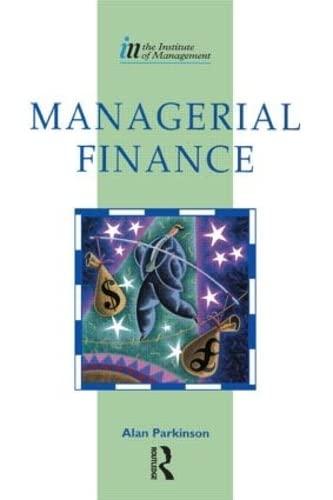Question
T. J. Patrick is a young, successful industrial designer in Portland, Oregon, who enjoys the excitement of commodities speculation. T. J. has been dabbling in
T. J. Patrick is a young, successful industrial designer in Portland, Oregon, who enjoys the excitement of commodities speculation. T. J. has been dabbling in commodities since he was a teen-ager-he was introduced to this market by his dad, who is a grain buyer for one of the leading food processors. T. J. recognizes the enormous risks involved in commodities speculating but feels that because he's young, he can afford to take a few chances. As a principal in a thriving industrial design firm, T. J. earns more than $150,000 a year. He follows a well-disciplined investment program and annually adds $15,000 to $20,000 to his portfolio. Recently, T. J. has started playing with financial futures-interest-rate futures, to be exact. He admits he is no expert in interest rates, but he likes the price action these investments offer. This all started several months ago, when T. J. met Vinnie Banano, a broker who specializes in financial futures, at a party. T. J. liked what Vinnie had to say (mostly how you couldn't go wrong with interest-rate futures) and soon set up a trading account with Vinnie's firm, Banano's of Portland. The other day, Vinnie called T. J. and suggested he get into 5-year Treasury note futures. He reasoned that with the Fed pushing up interest rates so aggressively, the short to intermediate sectors of the term structure would probably respond the most-with the biggest jump in yields. Accordingly, Vinnie recommended that T. J. short sell some 5-year T-note contracts. In particular, Vinnie thinks that rates on these T-notes should go up by a full point (moving from about 5.5% to around 6.5%) and that T. J. should short 4 contracts. This would be a $5,400 investment because each contract requires an initial margin deposit of $1,350. Questions a. Assume T-note futures ($100,000/contract; 32's of 1%) are now being quoted at 103-16. 1. Determine the current underlying value of this T-note futures contract. 2. What would this futures contract be quoted at if Vinnie is right and the yield does go up by 1 percentage point, to 6.5%, on the date of expiration? (Hint: It'll be quoted at the same price as its underlying security, which in this case is assumed to be a 5-year, 6% semiannual-pay U.S. Treasury note. If necessary, refer to Chapter 11 and review the material on pricing semiannual-pay bonds.) b. How much profit will T. J. make if he shorts 4 contracts at 103-16 and then covers when 5-year T-note contracts are quoted at 98-00? Also, calculate the return on invested capital from this transaction. c. What happens if rates go down? For example, how much will T. J. make if the yield on T-note futures goes down by just 3/4 of 1%, in which case these contracts would be trading at 105-8?
d. What risks do you see in the reccommended short sale transaction? What is your assessment of TJ's new interest in financial futures? How do you think it compares to hsi established commodities investment program?
Step by Step Solution
There are 3 Steps involved in it
Step: 1

Get Instant Access to Expert-Tailored Solutions
See step-by-step solutions with expert insights and AI powered tools for academic success
Step: 2

Step: 3

Ace Your Homework with AI
Get the answers you need in no time with our AI-driven, step-by-step assistance
Get Started


